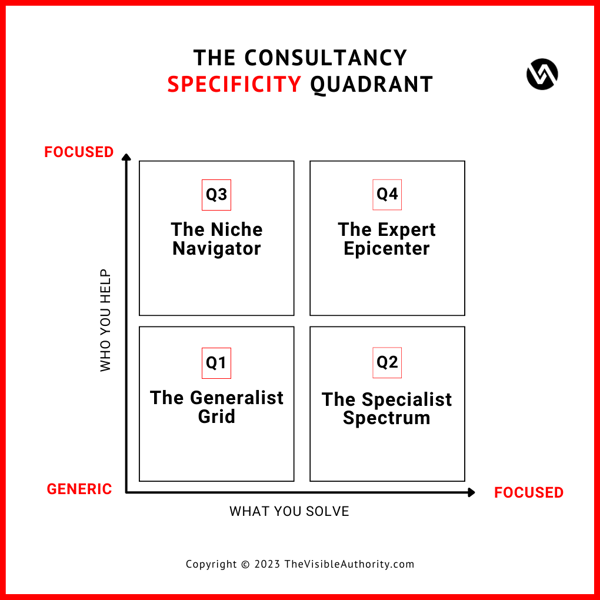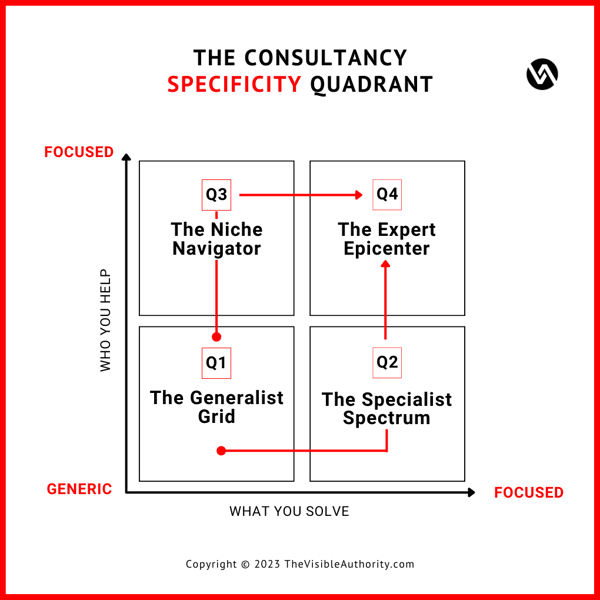
Mapping the Journey: The Consultancy Specificity Quadrant

Within the first two minutes of talking to an owner of a boutique consultancy new client, I ask a simple question: “What does your consultancy do?”
At this point, it comes as no surprise that owners of high-performing consultancies almost always succeed in giving me a 30-second answer that covers precisely what problem they are solving for which type of clients, how they do it, and what typical outcomes they can achieve.
Why? Because a high level of specificity and intentionality is at the foundation of their success and is displayed in the external messaging of these consulting firms. These consultancies are obsessed with specificity and are highly protective of it.
When I say “specificity”, I refer to two dimensions:
- specificity in the types of problems a consultancy solves with its services
- specificity in the kind of audience they cater to.
This is what I’ll be discussing in this article – how achieving relevance and deep expertise in a very specific field for a highly targeted audience can supercharge the growth and profitability of a boutique consultancy.
Shifting Gears: The Consultancy Specificity Quadrant
The success of a boutique consultancy hinges on its ability to define its area of expertise and target audience clearly and narrowly.
To help visualise it, I’ve created the consultancy specificity quadrant.

I argue that boutique consultancies must strive to be in the Expert Epicenter quadrant to improve success.
What do I mean by “success”? In my view, a boutique consultancy is considered successful when:
- It posts high project margins, north of 40% (or even better: >50%)
- It can forecast its revenue and project pipeline with high precision
- It has significantly lower costs than the average consultancy due to its commitment to optimising & standardising processes and methodologies.
- Owners and leaders of the consultancy can focus on running and developing the business instead of working in the service delivery trenches.
- Consultants work at a steady schedule – there are rarely periods of overstretching or underutilising them.
- It grows organically with prospects knocking on the door as opposed to having to chase leads and by developing the majority of the revenue from existing clients (70% is my sweet spot)
The Quadrants Explained
Before I explain why and how boutique consultancies should move from the Generalist Grid to the Expert Epicenter, I’ll clarify what each quadrant means.
The Generalist Grid (Q1): This quadrant represents consultancies that offer a broad range of solutions to a wide audience. These consultancies are jack-of-all-trades, offering services in various areas to clients from different sectors.
The Specialist Spectrum (Q2): Consultancies in this quadrant offer specialised solutions to a broad audience. They have developed expertise in a particular area, but their services apply to various industries/types of clients.
The Niche Navigator (Q3): This quadrant represents consultancies offering a broad range of solutions to a specific audience.
The Expert Epicenter (Q4): This is the quadrant of consultancies that offer specialised solutions to a specific audience. They have developed deep expertise in a particular area and cater to the unique needs of a specific sector or audience.
Standing out from the crowd requires a different approach in a world inundated with consultancies claiming they can do almost everything for everybody.
That’s where the Expert Epicenter quadrant comes in. It elevates boutique consultancies from obscurity to indispensability.
This quadrant is not just a tool to assess a consultancy; it's a challenge. It is a challenge to be specific, to be targeted, and to be an expert.
It's a call to move from the crowded ocean of the ‘we-can-do-it-all-consultancy’ to the small pond of targeted specialisation.
Recommended reading: Why High-Performance Consultancies Are Obsessed with Specificity
The journey to the Expert Epicenter quadrant
How long does the journey from Q1 (The Generalist Grid) to Q4 (The Expert Epicenter) take? In my experience working with small and medium-sized consultancies, it takes around 2-3 years of committed, targeted consulting work.
I will explain why it takes this long (although, in my opinion, 2-3 years to turn a business around entirely is not long at all) by going through the steps that a consultancy must take throughout the journey.
Developing laser-sharp positioning
First things first – a generalist boutique consultancy needs to determine the direction of specialisation: who the target client will be, what pain points the consultancy will address for this client, and how it will resolve this pain point.
The following two research steps are a must at this stage:
- Researching the market: This means deep-diving into the state of the selected industry/sub-sector, the most significant opportunities and challenges in the space, tech and systems utilised across companies, why dominant players can secure their position and more.
- Researching the clients: It is imperative to have an exceptional understanding of the prospective clients. What is their job within organisations? How do their decisions impact the rest of the business? What are their pain points and goals? How do these pain points fit in the larger context of their business? Consultancies need to learn all of this and more about their future target audience.
With these insights, the consultancy should determine its place with powerful, crystal-clear positioning.
Developing the service concept
Once the positioning has been developed, it’s time to zoom in on the service offering.
Here, the consultancy needs to complete the following steps:
- Developing the offering: This involves analysing past projects, conducting in-depth interviews with past clients, identifying patterns in the type of pain points clients in various industries struggle with, ranking these pain points from most pressing/high-impact to not sufficiently important, etc.
- Validating the offering: Not all service offering concepts pan out. That’s why conducting a market-product fit analysis is crucial before fully committing. The consultancy needs to take its offering idea and validate it first.
Crystalising and streamlining the service concept
Now that the consultancy has a solid idea of what type of pain point it wants to resolve for which clients, it’s time to get into the nitty-gritty of service design. This includes:
- Ensuring repeatability of the service: The consultancy must design a service in a way that requires little to no customisation. It can be replicated and delivered consistently across different clients and scenarios. Repetition in work is the only way to consistently grow the depth of expertise, lower costs by optimising processes, deliver guaranteed results for clients, and identify patterns to increase the value of work further.
- Securing metrics, data, and benchmarks: How will the consultancy measure the impact of its work? How will it measure the effectiveness of the service to both explain the transformational impact of its work to prospects and continuously improve the offering? Furthermore, the consultancy needs to create a system for aggregating this data over time. This will allow it to develop proprietary datasets and establish benchmarks. There is tremendous value in creating exclusive, proprietary data sets – they help consultancies strengthen their credibility and encourage clients to check out their expertise. If meticulously aggregated and maintained, this data can evolve into a unique proprietary asset or intellectual property, increasing the firm's monetary value and enabling it to charge premium fees.
- Developing a stable process and methodology: The consultancy undergoing the journey to the fourth quadrant must have a solid service delivery process. From what tools and expertise will be required to complete projects to what onboarding of clients will look like to the average length of engagement and the milestones to reach for each client – there are dozens of small and large elements that must be accounted for and planned for.
- Making the solution scalable: It is essential that the service offering designed by the consultancy can be scaled up or down without compromising on the quality of outcomes. This will add agility to the firm and, at the same time, predictability in terms of revenue, pipeline forecasting and management, and resource allocation.
Making internal preparations
Once the new service offering is designed, validated, and streamlined, it’s time to prepare the team and the necessary resources. This involves:
- Training the team and documenting the process for new hires: Every team member – from consultants to marketers and support/admin staff – needs to undergo thorough training on the new service, the methodology, the newly defined positioning, and the strategic vision of why and how the business is experiencing this transformation. Furthermore, the training process must be diligently documented to optimise the onboarding process of new hires in the future.
- Creating a system to document learnings: This step is essential for internal learnings/improvements and target audience education. There is a wealth of knowledge and experience gained from past successes, failures, and struggles that can be used to educate clients and team members. The consultancy must set up a system to capture and share these learnings regularly.
- Setting up a tech stack: Here, I’m referring to the technological tools the consultancy will utilise internally to deliver work to its clients and the technologies it will integrate into its tech stacks.
Making external preparations
Depending on the service, the consultancy may need to incorporate external or industry-mandated requirements. For example:
- Obtaining certification: If there are market expectations or a requirement for possessing certain certification to offer this type of service, it’s imperative that the consultancy does so for all its consultants.
- Adhering to compliance requirements: Once again, if the industry/nature of the work performed for the client mandates adherence to specific rules and regulations, the consultancy must acquire a deep understanding of these rules and integrate compliance into its service delivery design.
Redefining marketing, business development, and sales strategies
Now that the internal and external preparations are done, the consultancy needs to define the strategy and parameters of its client recruitment efforts. Some of the elements the consultancy must consider are:
- Collecting strong client testimonials: Social proof plays a significant role in the ability of a consultancy to attract clients. Just like we, as consumers, read reviews before purchasing a product, senior executives do their homework and read the testimonials from past clients. It is a way to minimise the risk of the purchase. And they are not looking for the general “this consultancy is great” type of testimonials. They want to hear how effectively the consultancy solved specific problems for other clients.
- Committing to audience education: To develop a reputation for deep expertise, the consultancy – and here, I’m talking about consulting leaders and consultants alike – must develop its voice and point of view. Each consultant should strive to become known as a thought leader within their niche. That means continuously creating and sharing content that educates the target audience. This is also how a consultancy builds trust with its prospects and how it gets discovered through online searches.
"There’s a chasm between an old-school and a new-school mindset. The old-school consultancy refuses to share its expertise. The belief is that clients and competitors will steal their know-how. The new-school consultancy believes in the power of sharing/educating and considers it strategic."
- Developing and documenting marketing and sales processes: What is the typical journey a prospect goes through before becoming a client? What are the main touchpoints and platforms the marketing team should focus on? What is the strategy for retaining clients? How are marketing efforts measured? There are a ton of questions that must be addressed and documented to optimise the effectiveness of marketing and sales down the line.
Recommended reading: Why Are Consultancies Appointing New Partners Without a Voice?
This list is by no means exhaustive. I can write twice as much on positioning alone. However, I hope I clarified why a boutique consultancy needs 2-3 years to move towards the Expert Epicenter quadrant.
The Non-linear Journey to the Expert Epicenter
I’ve learned in the past years that the journey to the Expert Epicenter is far from a straight path. It's a winding journey with twists, turns, advances, and retreats. Most consultancies, starting from the ‘we-can-do-it-all’ Generalist Grid of Q1, often find themselves meandering either through the Specialist Spectrum of Q2 or navigating the intricate paths of the Niche Navigator in Q3.
Each quadrant presents challenges and opportunities, and the progression is rarely linear. There will be moments of validation where the direction feels right, interspersed with instances of failure that necessitate recalibration. It's a dance of moving left and right, up and down, constantly refining and redefining one's focus.

With all its complexities, this journey is a testament to the evolving nature of consultancy, emphasising that success is not just about reaching a destination but also about the insights and growth experienced along the way.
I have written 2 case studies of consultancies that have moved to the Q4 Quadrant in several - sometimes tricky - steps. Recommended reading!
In conclusion
For boutique consultancies, success is all about 'being specific' about who they help and how they solve this target audience’s problems.
The Expert Epicenter quadrant represents the pinnacle of specificity, where consultancies offer specialised solutions to a specific audience.
By focusing on a targeted specialisation, a boutique consultancy can develop deep expertise, tailor its services to the unique needs of its audience, and establish itself as a trusted expert in its field.
Therefore, it is highly recommended that boutique consultancies strive to move towards the Expert Epicenter quadrant.
This focus will help differentiate the consultancy from competitors and lead to more meaningful and impactful relationships with clients.
Interested in receiving all my learnings to build a better consultancy?
Subscribe to my newsletter.

Luk’s extensive career in the consulting business, which spans more than 20 years, has seen him undertake a variety of influential positions. He served as the European CHRO for Nielsen Consulting (5,000 consultants in the EU), founded iNostix in 2008—a mid-sized analytics consultancy—and led the charge in tripling revenue post-acquisition of iNostix by Deloitte (in 2016) as a leader within the Deloitte analytics practice. His expertise in consultancy performance improvement is underlined by his former role on Nielsen's acquisition evaluation committee. After fulfilling a three-year earn-out period at Deloitte, Luk harnessed his vast experience in consultancy performance improvement and founded TVA in 2019. His advisory firm is dedicated to guiding consulting firms on their path to becoming high-performing firms, drawing from his deep well of consulting industry expertise and financial acumen.

